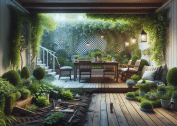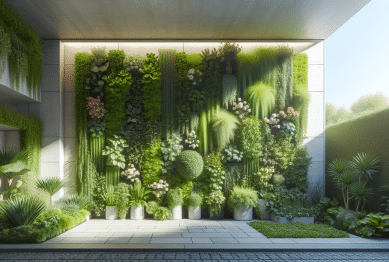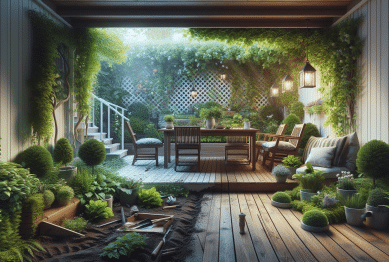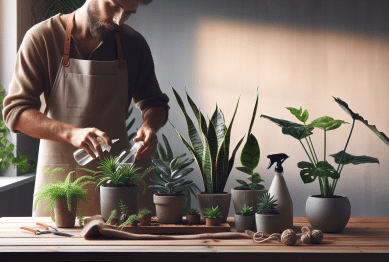Curious about how to make your garden more vibrant without big renovations? This guide explores creative, sustainable, and easy-to-maintain gardening ideas you can try at home. Discover clever landscaping, container gardening, water-wise solutions, and more to elevate your outdoor space and boost curb appeal.
Dreaming Up Garden Transformation Ideas
Imagining a refreshed garden can be inspiring for homeowners seeking to infuse natural beauty and functionality into their outdoor spaces. Whether the area is large or compact, landscape design possibilities are endless, allowing for stylish walkways, cozy seating areas, and fragrant blooms. Many gardeners begin the process by evaluating space, sunlight exposure, and how the garden is used day-to-day. Taking this practical approach ensures that the transformation is custom-fit to needs, budget, and climate. Personal touches, like decorative planters and inviting garden paths, further individualize the garden, making each project unique.
A key aspect of a successful transformation is harmonizing elements such as foliage, flowers, and hardscaping to create a cohesive look. For instance, blending evergreens with seasonal blooms provides year-round interest, while natural stone or gravel paths add structure and guide visitors through the garden. Raised beds can bring definition and make maintenance easier. Layered planting, using different plant heights and textures, looks stunning to the eye and encourages ecological diversity, welcoming pollinators and birds to the space. It’s not about grandeur; rather, it’s about crafting an outdoor retreat filled with personality.
Planning ahead is vital when redesigning any garden. Drawing a basic garden plan helps with visualizing where each feature will go. Consider easy-to-incorporate upgrades like container flower arrangements on patios, small water features for ambiance, or vertical gardening for privacy and productivity. Even simple enhancements such as new mulch, tidied borders, or switching annuals for perennials can deliver a noticeable transformation. For beginner and experienced gardeners alike, the key is to start with manageable projects and build on success.
Landscaping Ideas That Enhance Curb Appeal
Curb appeal starts with a tidy, well-defined landscape that invites the eye and frames your home attractively. Mulched flower borders, ornamental shrubs, and regularly mown lawns make a strong first impression. Adding color with flowering annuals or bulbs planted along pathways boosts beauty instantly. Even in small yards, using planting islands and feature planters by the entryway creates dimension and welcomes guests warmly (Source: https://hgic.clemson.edu/factsheet/improving-curb-appeal-with-landscaping/).
Clever landscaping isn’t limited to flowers and hedges. Small upgrades, like decorative edging or new house numbers, help tie the exterior look together. Lighting can also play a transformative role in curb appeal. Low-voltage or solar lights along driveways, walkways, and focal plants add warmth and make the garden and home appear more cared for and secure after dusk. Replacing an outdated mailbox, touching up paint, or power washing walkways can further support the refreshed look without breaking the bank.
Solving practical challenges can be attractive too. For example, using ground covers in tough spots where grass struggles creates lush, easy-care zones. Native plants chosen for local soil and rainfall patterns generally need less maintenance and provide year-long interest. Mixing evergreens with deciduous trees or including ornamental grasses ensures something interesting is always happening visually, which is especially effective in front yard landscaping.
Container Gardening for Flexibility and Style
Container gardening is gaining popularity for its versatility in bringing color and life to patios, balconies, and small-space gardens. Using pots, troughs, and baskets, gardeners of all skill levels can easily switch out plants by season, try out new species, or create themed displays such as edible herb gardens or pollinator pots. Containers can be full of vibrant flowers, lush foliage, or even miniature trees, adapting effortlessly to garden trends and homeowner preferences.
Using high-quality potting mix, drainage materials, and proper plant choices ensures container gardens thrive. It’s always smart to select pots large enough for root growth but light enough to shift as needed. Grouping containers in odd numbers, or arranging by height, creates visual impact. For families with children or busy schedules, self-watering containers or drought-tolerant plants reduce daily maintenance but keep the garden looking its best throughout the growing season (Source: https://extension.umn.edu/flowers/container-gardening).
Container gardens aren’t limited to just flowers. Leafy greens, tomatoes, peppers, and even dwarf fruit trees can be cultivated in pots for a decorative and productive focus. Mobility is an added bonus—gardeners can move delicate plants out of harsh weather or reposition showy displays for special events. Adding colorful pots, recycled planters, or creative containers (like watering cans or crates) increases the garden’s personality and makes the most of limited outdoor spaces.
Water-Wise Gardening: Saving Resources and Money
Efficient water management is central to both sustainable gardening and savings on utility costs. Xeriscaping, or creating gardens that need minimal irrigation, relies on drought-tolerant plants, mulch, and smart design. Native species often suit local weather, needing less water and fertilizer. Grouping plants by their water needs, known as hydrozoning, ensures that thirsty species like annuals don’t increase water bills for the entire garden (Source: https://www.epa.gov/watersense/water-efficient-landscaping).
Rain barrels can store water for dry spells, while permeable paths and mulched beds reduce evaporation and runoff. For gardeners eager to conserve, installing drip irrigation or soaker hoses delivers water precisely to roots, eliminating wastage. Choosing cool-season grasses or replacing lawns with low-growing herbs like thyme or creeping Jenny also leads to significant savings over time and supports pollinators in the landscape.
Water-wise gardening has become a popular topic in communities looking to balance beauty with sustainability. Benefits extend beyond cost: water-efficient gardens are resilient in drought years and require less effort to keep healthy. Replacing thirsty ornamental plants with drought-hardy alternatives creates less stress during heat waves and aligns with environmental goals. The result is a vibrant, hardy garden that conserves valuable resources.
Edible Gardens: From Raised Beds to Kitchen Containers
Growing food at home delivers culinary satisfaction and teaches valuable skills. Raised vegetable beds offer easier access, better drainage, and control over soil quality. Salad greens, beans, strawberries, or even carrots can be cultivated in compact beds or planters and picked straight into the kitchen. Edible landscaping, or the combination of beauty and productivity, allows herbs and fruit shrubs to double as decorative specimens in borders and along walkways (Source: https://nifa.usda.gov/food-gardening).
Container vegetable gardening is particularly convenient for those with limited space or mobility. Kitchen herbs such as basil, thyme, and chives do well on sunny windowsills or patios while root vegetables and leafy greens thrive in deep troughs or grow bags. This approach makes it possible to have fresh produce almost year-round. Vertical garden towers and wall planters also help maximize harvests while saving space and adding interest to bare walls or fences.
Edible gardens promote sustainable living by encouraging seasonal eating and reducing food miles. Many find gardening therapeutic and rewarding, as it delivers a sense of accomplishment alongside nutritious harvests. Even with minimal space or experience, households can contribute to their wellness by cultivating just a few useful crops—which can also help lower grocery bills and inspire new cooking adventures at home.
Low-Maintenance Garden Solutions
Homeowners often seek ways to enjoy a garden without heavy upkeep. Low-maintenance gardening focuses on perennial plants, automatic irrigation, and groundcovers that suppress weeds and reduce the need for mowing. Mulching, using bark or gravel, deters weed growth and keeps moisture in the soil, which reduces watering needs and helps plants thrive even during dry spells.
Choosing plants that are disease-resistant or native helps eliminate common challenges such as soil-borne pests or leaf diseases, decreasing dependence on chemical treatments. Simple garden structures like trellises, benches, and sculpture add character that lasts for years with minimal attention. Installing pathways of pavers or stepping stones through garden beds prevents soil compaction and directs traffic, keeping plants healthy and tidy.
For those busy with family, work, or travel, technology can lend a helping hand. Smart irrigation controllers adjust watering schedules based on rainfall, while solar-powered lights illuminate pathways autonomously. Low-maintenance doesn’t mean plain—these gardens can be lush, colorful, and full of life with a little smart planning and strategic plant selection (Source: https://hgic.clemson.edu/factsheet/low-maintenance-landscape-ideas/).
References
1. Clemson Cooperative Extension. (n.d.). Improving curb appeal with landscaping. Retrieved from https://hgic.clemson.edu/factsheet/improving-curb-appeal-with-landscaping/
2. University of Minnesota Extension. (n.d.). Container gardening. Retrieved from https://extension.umn.edu/flowers/container-gardening
3. U.S. Environmental Protection Agency. (n.d.). Water-efficient landscaping. Retrieved from https://www.epa.gov/watersense/water-efficient-landscaping
4. USDA National Institute of Food and Agriculture. (n.d.). Food gardening. Retrieved from https://nifa.usda.gov/food-gardening
5. Clemson Cooperative Extension. (n.d.). Low-maintenance landscape ideas. Retrieved from https://hgic.clemson.edu/factsheet/low-maintenance-landscape-ideas/
6. Royal Horticultural Society. (n.d.). Sustainable gardening. Retrieved from https://www.rhs.org.uk/advice/profile?pid=910









